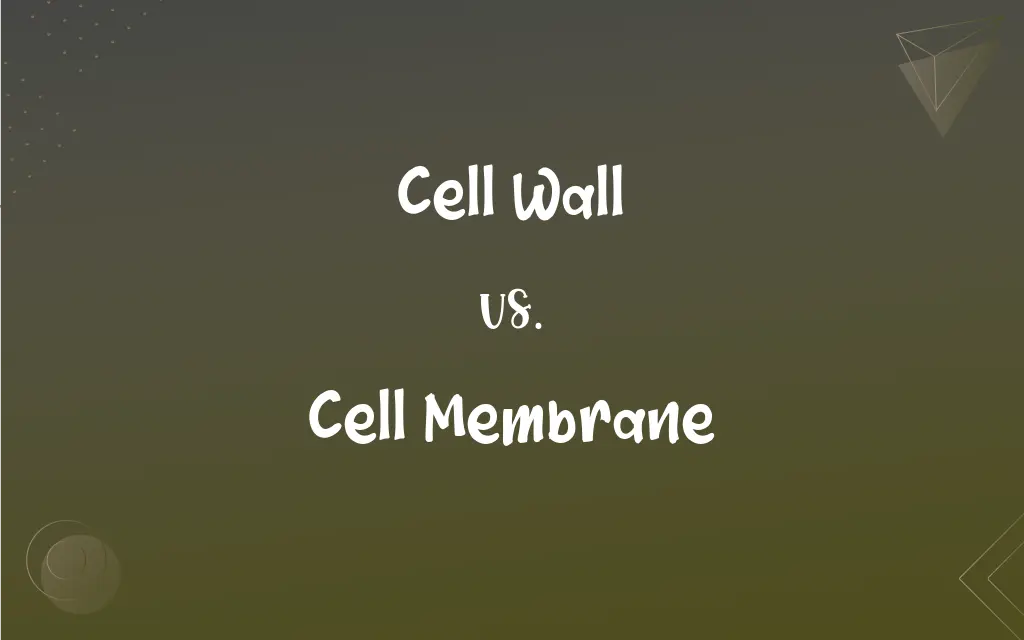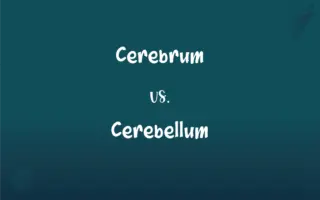Cell Wall vs. Cell Membrane: What's the Difference?
Edited by Aimie Carlson || By Harlon Moss || Updated on October 7, 2023
Cell wall, found in plants, fungi, and certain bacteria, provides shape and support, whereas the cell membrane, present in all cells, controls substance entry and exit.

Key Differences
The cell wall is a rigid structure enveloping the cell membrane in certain organisms, notably plants, bacteria, and fungi. It provides a defined shape and protective barrier, safeguarding the cell from external stresses and preventing excessive water uptake. Contrarily, the cell membrane exists in all living cells, offering a selectively permeable boundary that manages the passage of substances in and out of the cell.
Cell wall composition varies across species; plant cell walls contain cellulose, bacterial walls utilize peptidoglycan, and fungal walls incorporate chitin. The cell membrane, regardless of organism type, typically exhibits a phospholipid bilayer embedded with proteins, facilitating diverse functions such as signal transduction, substance transport, and cellular recognition.
While the cell wall is predominantly a structural component, influencing turgor pressure and maintaining cellular integrity, the cell membrane predominantly regulates intra and extracellular environments. It ensures the equilibrium of ions, nutrients, and waste products, maintaining an optimal internal environment and contributing to homeostasis.
The cell wall's rigidity contrasts distinctly with the flexibility of the cell membrane. The cell wall ensures mechanical strength and maintains cellular shape, whereas the cell membrane dynamically alters its shape during processes like endocytosis and facilitates cellular interactions. In certain cells, the absence of a cell wall, such as in animal cells, allows for varied shapes and enhanced mobility, as observed in amoebas and white blood cells.
In a nutritional and metabolic context, the cell wall stores carbohydrates that can be broken down and utilized during periods of scarcity. On the other hand, the cell membrane facilitates nutrient uptake, waste elimination, and mediates the interactions of signal molecules, playing a pivotal role in cellular communication and metabolic regulation.
ADVERTISEMENT
Comparison Chart
Presence
In plants, fungi, and bacteria
In all cell types
Function
Provides support and shape
Regulates substance entry/exit
Composition
Varies (e.g., cellulose, chitin)
Phospholipid bilayer with embedded proteins
Rigidity/Flexibility
Rigid
Flexible
Role in Metabolism
Carbohydrate storage
Nutrient uptake and waste elimination
ADVERTISEMENT
Cell Wall and Cell Membrane Definitions
Cell Wall
The cell wall is a rigid, protective layer outside the cell membrane in plant, fungal, and bacterial cells.
The cell wall in plants gives them a defined shape and prevents them from bursting in hypotonic solutions.
Cell Membrane
The cell membrane maintains homeostasis by regulating substance concentrations inside the cell.
Through active transport, the cell membrane ensures ion balance within the cell.
Cell Wall
It predominantly consists of carbohydrate structures, such as cellulose in plants.
In times of nutrient scarcity, the cell wall can provide resources for the cell.
Cell Membrane
It allows the cell to interact with its environment, perceiving and responding to changes.
The cell membrane perceives hormonal signals, instigating cellular responses.
Cell Wall
It protects the cell from physical stress and prevents excessive water absorption.
A bacterium's cell wall safeguards it from osmotic lysis in hypotonic environments.
Cell Membrane
The cell membrane can dynamically change shape, enabling processes like endocytosis and exocytosis.
During phagocytosis, the cell membrane engulfs foreign particles, internalizing them.
Cell Wall
The cell wall offers mechanical support and determines the cell’s shape and rigidity.
The robustness of a tree trunk is significantly due to the cell walls of its constituent cells.
Cell Membrane
The cell membrane is a selectively permeable barrier surrounding all living cells.
The cell membrane controls the entry of glucose molecules into the cell.
Cell Wall
The cell wall in plants aids in transferring water and dissolved substances, providing a pathway between cells.
Water moves through plant cell walls via capillary action, aiding in its upward transport through the plant.
Cell Membrane
Comprising a phospholipid bilayer, it embeds proteins enabling various functions, such as transport and signaling.
Embedded proteins in the cell membrane facilitate communication between cells via signal transduction.
FAQs
Do animal cells have a cell wall?
No, animal cells do not have a cell wall.
What is the primary function of the cell wall?
To provide support, protection, and shape to the cell.
What is the cell wall primarily made of in plants?
Cellulose.
How does the cell wall support turgor pressure in plants?
It resists the outward pressure exerted by the cell's contents, helping the plant maintain its shape.
What is the role of lignin in the cell wall?
Lignin strengthens and waterproofs the cell wall, especially in woody plants.
How does the cell membrane differ in composition from the cell wall?
The cell membrane consists mainly of lipids and proteins, whereas the cell wall's composition varies by organism (e.g., cellulose in plants).
How does cholesterol function in the cell membrane?
It helps modulate membrane fluidity and stability.
What is the cell membrane primarily made of?
A lipid bilayer interspersed with proteins.
How does the cell membrane maintain cell homeostasis?
By controlling the passage of molecules, maintaining a balance between the inside and outside of the cell.
Do all cells have a cell membrane?
Yes, all cells, whether prokaryotic or eukaryotic, have a cell membrane.
What is a cell wall?
A protective layer outside the cell membrane, found mainly in plants, bacteria, fungi, and algae.
How does the cell wall differ from the cell membrane?
The cell wall is a rigid outer layer, while the cell membrane is a flexible, semi-permeable barrier.
Do all cells have a cell wall?
No, only certain organisms like plants, bacteria, fungi, and algae have cell walls.
What is the fluid mosaic model?
A description of the cell membrane's structure, depicting it as a flexible layer of lipids with embedded proteins.
Is the cell membrane visible under a light microscope?
Typically, no. It's better visualized under an electron microscope.
Which organisms have peptidoglycan in their cell walls?
Bacteria.
How does the cell wall aid in cell-to-cell communication?
Through plasmodesmata, small channels that allow molecules and substances to move between plant cells.
What is the cell membrane?
A semi-permeable barrier that surrounds the cytoplasm of a cell.
What is the primary function of the cell membrane?
To regulate the entry and exit of substances into and out of the cell.
What role do proteins play in the cell membrane?
Proteins assist in transport, signal reception, enzymatic activity, and cell-to-cell recognition.
About Author
Written by
Harlon MossHarlon is a seasoned quality moderator and accomplished content writer for Difference Wiki. An alumnus of the prestigious University of California, he earned his degree in Computer Science. Leveraging his academic background, Harlon brings a meticulous and informed perspective to his work, ensuring content accuracy and excellence.
Edited by
Aimie CarlsonAimie Carlson, holding a master's degree in English literature, is a fervent English language enthusiast. She lends her writing talents to Difference Wiki, a prominent website that specializes in comparisons, offering readers insightful analyses that both captivate and inform.































































